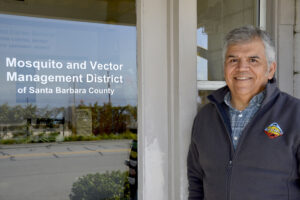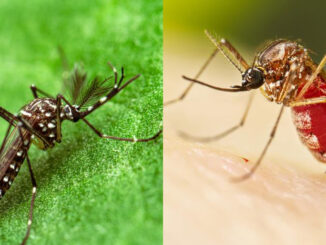
The Mosquito & Vector Management District of Santa Barbara County protects public health by controlling mosquitoes, ticks, and other disease-carrying pests
by Elizabeth Ann Morabito
In 2020, a Santa Barbara resident noticed something strange—mosquitoes biting during the day and relentlessly swarming his ankles. The Mosquito & Vector Management District of Santa Barbara County (MVMD) confirmed the worst: Aedes aegypti had arrived.
This invasive mosquito species is known for spreading unchecked across California.
It is a carrier of dangerous diseases—dengue, Zika, and Chikungunya viruses—each with potentially severe consequences, posing a serious public health threat.
The District performs outstanding work…monitoring vector presence and performing eradication of mosquito larvae pools.
Dr. Henning Ansorg, public health officer in Santa Barbara County
Unlike most mosquitoes, this particular species thrives both indoors and outdoors. Even the smallest puddle—such as a toothbrush holder or leftover water in a coffee maker—can become a breeding ground. This adaptability makes ‘ankle biters’ particularly difficult to control.

Photo credit Nell Campbell
Even so, against all odds, Santa Barbara County became one of the only places to eliminate Aedes aegypti entirely—an achievement very few regions can claim.
“My main concern was to try to stop these infestations from spreading, to keep them contained,” says Brian Cabrera, general manager of MVMD. “To make a long story short, we haven’t seen them since 2021.”
That victory wasn’t luck. It was earned through a coordinated months-long effort, including:
- Door-to-door neighborhood inspections
- Educational campaigns to help residents identify the mosquito
- Environmentally safe treatments at breeding sites
Aedes aegypti has yet to return. Still, Cabrera remains cautious.
“I can’t pat ourselves on the back for getting rid of them,” Cabrera warns. “They can always come back, and come back with a vengeance.”
Unlike other areas of the county that opted out of mosquito control services, Santa Barbara, Goleta, and Carpinteria benefit from dedicated vector management. MVMD is a special district—the most local form of government—created by a vote of the residents to provide targeted public health services.
“We’re not part of the county government. We’re not part of the city government. We’re not part of the state government,” Cabrera explains.
Funding comes directly from property tax assessments, ensuring continued mosquito and vector control in the communities that choose to support it.
It is only because of the District’s work that vectors—organisms that bite or sting and can transmit disease, as Cabrera explains—are kept in check. Although Aedes aegypti was eradicated, there is still much work to do.
MVMD’s efforts primarily involve monitoring and controlling other mosquito species and ticks, and responding to rat infestations, all of which pose ongoing public health risks. They do all this with a team of just six: four technicians, one administrative assistant, and Cabrera.
Santa Barbara County Public Health Officer Dr. Henning Ansorg stresses how vital this ongoing surveillance is to protecting public health. He explains that if local disease clusters were ever detected—especially of serious mosquito-borne illnesses like dengue or Zika—it could require extensive investigations and possibly even isolation or quarantine measures. MVMD’s early monitoring efforts help prevent those worst-case scenarios from becoming reality.
Ansorg further underscores MVMD’s essential role: “The District performs outstanding work in educating the public on how to minimize exposure to dangerous mosquitoes and ticks, as well as monitoring vector presence and performing eradication of mosquito larvae pools.”
What does the future hold? Climate patterns continue to shift resulting in extended periods of warmer weather. Intensive control efforts will be needed for larger populations of mosquitoes over a longer period of time during the year. Coupled with an increased need due to a growing residential population, operational costs are on the rise.
“Hiring more people, getting more equipment…that all costs money,” Cabrera shares.
Keeping these protections in place won’t be possible without continued support. The District anticipates reaching the maximum amount they’re allowed to assess within the next couple of years. To increase funding to sustain its efforts, the District will need voter approval.
Dr. Ansorg notes that sustained prevention efforts are far more cost-effective than trying to contain an outbreak after it starts—a costly lesson many other counties have learned the hard way.
Because of the District’s relentless efforts, Santa Barbara County remains one of the few places in California free from Aedes aegypti. But, Cabrera’s warning is clear: the ‘ankle biter’ may be gone for now—but it takes constant vigilance to keep them from returning.
How you can help keep Santa Barbara County safe:
- Spot unusual mosquito activity? Especially daytime ankle biters? It could be invasive Aedes aegypti—report immediately: mvmdistrict.org/contact-us or call (805) 969-5050.
- See standing water or a neglected pool? Let MVMD know: mvmdistrict.org/contact-us or call (805) 969-5050.
- Found a dead bird? It may be linked to West Nile Virus. Report it to the California Department of Public Health: westnile.ca.gov/report.



